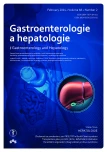Liver transplantation for hepatocellular carcinoma, long-term outcomes and risk factors of tumour recurrence (single-centre experience)
Authors:
R. Šenkeříková 1; S. Fraňková 1
; J. Šperl 1
; M. Oliverius 2; J. Froněk 2; E. Kieslichová 3
; H. Filipová 4; D. Kautznerová 4; E. Honsová 5; P. Trunečka 6; J. Špičák 1
Authors‘ workplace:
Klinika hepatogastroenterologie, IKEM, Praha
1; Klinika transplantační chirurgie, IKEM, Praha
2; Klinika anesteziologie, resuscitace a intenzivní péče, IKEM, Praha
3; Pracoviště radiodiagnostiky a intervenční radiologie, IKEM, Praha
4; Pracoviště klinické a transplantační patologie, IKEM, Praha
5; Transplantcentrum, IKEM, Praha
6
Published in:
Gastroent Hepatol 2014; 68(2): 139-145
Category:
Hepatology: Original Article
Overview
Background and aims:
Liver transplantation (OLT) is currently the treatment of choice for hepatocellular carcinoma (HCC) in cirrhotic liver, because it removes the tumour as well as the cirrhotic tissue with malignant potential. However, OLT improves survival especially in patients with a small tumour, who have a low risk of tumour recurrence after OLT. The aim of our study was to retrospectively analyse survival of patients who underwent liver transplantation for HCC in our centre and to identify the risk factors of tumour recurrence after OLT.
Patient characteristics:
Eighty-one adult patients who underwent liver transplantation in our centre for HCC (HCC group) were enrolled into the study. They all complied with the extended indication criteria (HCC < 6.5 cm) and 61/81 also met the Milan criteria (HCC < 5 cm). The control group consisted of 606 patients transplanted for end-stage liver disease without evidence of tumour (Ci group) within the same period.
Results:
1-, 3- and 5-year overall survival was worse in HCC patients compared with the Ci group (HCC 77%, 70% and 66% vs Ci 93%, 90% and 87%, p < 0.001). Long-term survival is comparable with foreign transplant centres in the Metroticket Group (5-year survival 71.2% and 10-year survival 58.4% if the extended criteria are met). 13/81 (16%) patients experienced HCC recurrence, and the median time to recurrence after OLT was 182 days (101–2322).
Conclusions:
Higher AFP value before OLT, the largest node size and proved angioinvasion represented the independent predictive factors of tumour recurrence. To achieve even better results, regular screening of risk groups of cirrhotic patients resulting in detection of small tumours and their early referral to OLT is crucial.
Key words:
liver transplantation – hepatocellular carcinoma – recurrence – survival – cirrhosis
The authors declare they have no potential conflicts of interest concerning drugs, products, or services used in the study.
The Editorial Board declares that the manuscript met the ICMJE „uniform requirements“ for biomedical papers.
Submitted:
6. 3. 2014
Accepted:
7. 4. 2014
Sources
1. Jemal A, Bray F, Center MM et al. Global cancer statistics. CA Cancer J Clin 2011; 61(2): 69–90. doi: 10.3322/caac.20107.
2. Sangiovanni A, Prati GM, Fasani P et al. The natural history of compensated cirrhosis due to hepatitis C virus: A 17-year cohort study of 214 patients. Hepatology 2006; 43(6): 1303–1310.
3. Ústav zdravotnických informací a statistiky ČR. [online]. Dostupné z: http://www.uzis.cz/registry-nzis/nor.
4. Llovet JM, Schwartz M, Mazzaferro V. Resection and liver transplantation for hepatocellular carcinoma. Semin Liver Dis 2005; 25(2): 181–200.
5. Mazzaferro V, Bhoori S, Sposito C et al. Milan criteria in liver transplantation for hepatocellular carcinoma: an evidence-based analysis of 15 years of experience. Liver Transpl 2011; 17 (Suppl 2): S44–S57. doi: 10.1002/lt.22365.
6. Bismuth H, Chiche L, Adam R et al. Liver resection versus transplantation for hepatocellular carcinoma in cirrhotic patients. Ann Surg 1993; 218(2): 145–151.
7. Mazzaferro V, Regalia E, Doci R et al. Liver transplantation for the treatment of small hepatocellular carcinomas in patients with cirrhosis. N Engl J Med 1996; 334(11): 693–699.
8. Yao FY, Ferrell L, Bass NM et al. Liver transplantation for hepatocellular carcinoma: comparison of the proposed UCSF criteria with the Milan criteria and the Pittsburgh modified TNM criteria. Liver Transpl 2002; 8(9): 765–774.
9. Duffy JP, Vardanian A, Benjamin E et al. Liver transplantation criteria for hepatocellular carcinoma should be expanded: a 22-year experience with 467 patients at UCLA. Ann Surg 2007; 246(3): 502–509; discussion: 509–511.
10. Mazzaferro V, Llovet JM, Miceli R et al. Predicting survival after liver transplantation in patients with hepatocellular carcinoma beyond the Milan criteria: a retrospective, exploratory analysis. Lancet Oncol 2009; 10(1): 35–43. doi: 10.1016/S1470-2045(08)70284-5.
11. Llovet JM, Ricci S, Mazzaferro V et al. Sorafenib in advanced hepatocellular carcinoma. N Engl J Med 2008; 359(4): 378–390. doi: 10.1056/NEJMoa0708857.
12. Bruix J, Sherman M. Management of hepatocellular carcinoma: an update. Hepatology 2011; 53(3): 1020–1022. doi: 10.1002/hep.24199.
13. Brůha R, Šperl J, Urbánek P et al. Doporučený postup pro léčbu a diagnostiku hepatocelulárního karcinomu. Gastroent Hepatol 2012; 66(2): 83–92.
14. Adamcová-Selčanová S, Badinková J, Skladaný Ľ. Hepatocelulárny karcinóm (HCC). Gastroent Hepatol 2013; 67 (Suppl 3): S17.
15. Roayaie S, Schwartz JD, Sung MW et al. Recurrence of hepatocellular carcinoma after liver transplant: patterns and prognosis. Liver Transpl 2004; 10(4): 534–540.
16. Regalia E, Fassati LR, Valente U et al. Pattern and management of recurrent hepatocellular carcinoma after liver transplantation. J Hepatobiliary Pancreat Surg 1998; 5(1): 29–34.
17. Sotiropoulos GC, Molmenti EP, Lösch C et al. Meta-analysis of tumor recurrence after liver transplantation for hepatocellular carcinoma based on 1,198 cases. Eur J Med Res 2007; 12(10): 527–534.
Labels
Paediatric gastroenterology Gastroenterology and hepatology SurgeryArticle was published in
Gastroenterology and Hepatology

2014 Issue 2
- Metamizole vs. Tramadol in Postoperative Analgesia
- Metamizole at a Glance and in Practice – Effective Non-Opioid Analgesic for All Ages
- Possibilities of Using Metamizole in the Treatment of Acute Primary Headaches
- Current Insights into the Antispasmodic and Analgesic Effects of Metamizole on the Gastrointestinal Tract
- Spasmolytic Effect of Metamizole
Most read in this issue
- Hereditary angioedema as a cause of abdominal pain
- Budd-Chiari syndrome and TIPS – 21 years’ experience
- Therapy of portal hypertension using transjugular intrahepatic portosystemic shunt – first 1,000 procedures in UH Hradec Kralove
- Modern diagnostics of Lynch syndrome
